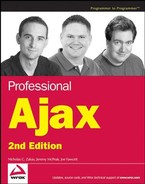1.5. Technologies behind Ajax
Garrett's article mentions several technologies that he sees as parts of an Ajax solution. These are:
HTML/XHTML: Primary content representation languages
CSS: Provides stylistic formatting to XHTML
DOM: Dynamic updating of a loaded page
XML: Data exchange format
XSLT: Transforms XML into XHTML (styled by CSS)
XMLHttp: Primary communication broker
JavaScript: Scripting language used to program an Ajax engine
In reality, all these technologies are available to be used in Ajax solutions, but only three are required: HTML/XHTML, DOM, and JavaScript. XHTML is obviously necessary for the displaying of information, while the DOM is necessary to change portions of an XHTML page without reloading it. The last part, JavaScript, is necessary to initiate the client-server communication and manipulate the DOM to update the web page. The other technologies in the list are helpful in fine-tuning an Ajax solution, but they aren't necessary.
There is one major component that Garrett neglected to mention in his article: the necessity of server-side processing. All of the previously listed technologies relate directly to the client-side Ajax engine, but there is no Ajax without a stable, responsive server waiting to send content to the engine. For this purpose, you can use the application server of your choice. Whether you choose to write your server-side components as PHP pages, Java servlets, or .NET components, you need only ensure that the correct data format is being sent back to the Ajax engine.
The examples in this book make use of as many server-side technologies as possible to give you enough information to set up Ajax communication systems on a variety of servers. Most of the examples covered in the book are available in PHP, JSP, and ASP.NET versions at www.wrox.com.
